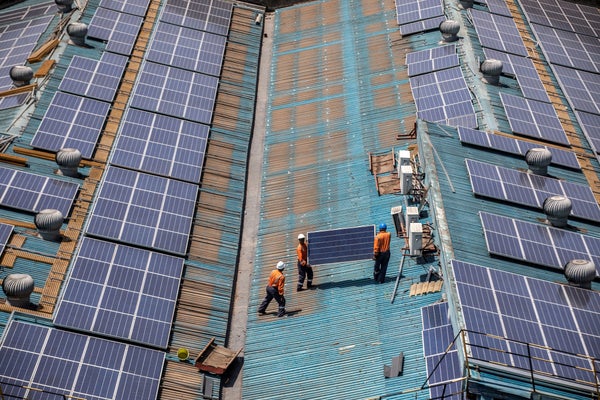Clean Energy Spending Will Surpass $2 Trillion This Year
Investments in carbon-free energy will be twice as large as fossil fuel spending in 2024, the International Energy Agency predicts

Technicians from CP Solar work on the maintenance of solar panels at a partially solar-powered factory in the industrial area of Nairobi, on October 9, 2023. Renewable energy sources generate over 80 percent of Kenya’s electricity.
Luis Tato/AFP via Getty Images
CLIMATEWIRE | Clean energy is on fire.
Global spending on renewables, nuclear, energy efficiency and low-emissions fuels like hydrogen is set to eclipse $2 trillion in 2024, double the $1 trillion spent on fossil fuels, according to the International Energy Agency’s annual review of global energy spending.
The transformation is particularly strong in the power sector, where worldwide investment in solar ($500 billion) is set to exceed spending on all other forms of power generation combined.
On supporting science journalism
If you’re enjoying this article, consider supporting our award-winning journalism by subscribing. By purchasing a subscription you are helping to ensure the future of impactful stories about the discoveries and ideas shaping our world today.
The IEA’s annual World Energy Investment report is closely tracked by industry analysts as a leading indicator for trends in the energy industry. This year’s report predicts that spending on clean energy will grow by almost 6 percent, up from nearly $1.9 trillion in 2023.
The report also notes an uptick in clean energy spending in emerging markets, a critical development for reaching the world’s climate targets. And it provides evidence that the wave in green energy spending sought by President Joe Biden, with passage of the Inflation Reduction Act in 2022, is starting to take root. U.S. spending on clean energy is projected to increase by $300 billion this year.
The findings are particularly notable because they come at a time when high interest rates threaten to stymie the expansion of cleaner energy sources. But the impact of higher borrowing costs has been offset by easing supply chain constraints and continued cost declines in renewable energy technologies, the IEA said.
“Clean energy investment is setting new records even in challenging economic conditions, highlighting the momentum behind the new global energy economy,” IEA Executive Director Fatih Birol said in a statement. “For every dollar going to fossil fuels today, almost two dollars are invested in clean energy.”
But significant challenges remain. The report notes that the biggest increase in new coal capacity occurred last year since 2015. Spending on oil and gas production, meanwhile, is on track to increase 7 percent to $570 billion. And while clean energy spending continues to grow, it is not happening fast enough to limit global temperature rise to 1.5 degrees Celsius.
IEA reckons that the current level of spending is enough to achieve two-thirds of the investment needed to triple renewable capacity by the end of the decade, as agreed to by negotiators at global climate talks in Dubai, United Arab Emirates, last year.
In emerging markets, energy spending is on track to approach $320 billion this year. That represents a 50 percent increase over 2020 levels and suggests new policy measures intended to green the energy supply are starting to take root. But despite the growth, emerging markets only account for 15 percent of global clean energy spending. That figure will have to increase if the world is to have any hope of reaching its climate goals, the IEA said.
“More must be done to ensure that investment reaches the places where it is needed most, in particular the developing economies where access to affordable, sustainable and secure energy is severely lacking today,” Birol said.
Renewables are expected to account for the largest portion of clean energy spending in 2024, at $771 billion. That would be up from $735 billion last year and $446 billion in 2020. Investments in energy efficiency measures are expected to hit $669 billion, up from $646 billion last year, while grid and storage investments are project to grow from $416 billion in 2023 to $452 billion this year.
Reprinted from E&E News with permission from POLITICO, LLC. Copyright 2024. E&E News provides essential news for energy and environment professionals.


























































